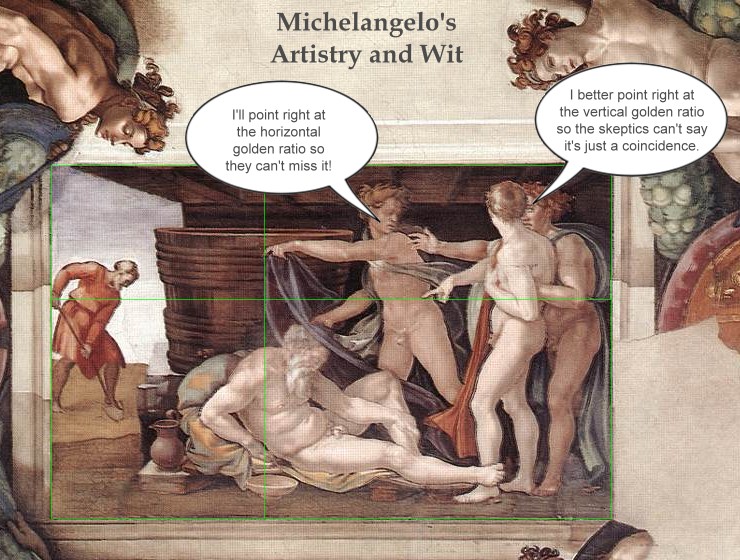In this set of lectures, I've been reintroduced to what happens when mathematics and art collaborate in both nature and human creations.
According to Wolfram MathWorld, the golden ratio, one of many examples of the prominence of mathematics in nature, is a "number often encountered when taking the ratios of distances in simple geometric figures". In art and in nature, the golden ratio embodies the 'perfect' proportions of an image. For example, in nature, the ideal positioning of flower petals to absorb the most sunlight is a factor of the golden ratio, and the number of petals is always a Fibonacci number. Similarly, artists commonly use this mathematical concept to create an aesthetic appeal in their pieces. Michelangelo applied this over a dozen times in the Sistine Chapel. Along with other aspects of the paintings, the hands of figures are pointing directly at golden ratio points. Thus, Michelangelo's use of the golden ratio in various parts of the paintings allowed him to subtly create an image that visually draws in viewers.
An example of the golden ratio in Michelangelo's "Drunkenness of Noah" painting of the Sistine Chapel
What is it about classical music that makes it so soothing to listen to? The use of mathematics in music creates an arrangement of tones and harmonies that appeals to listeners. Several composers have used numbers to create musical masterpieces that have endured to this day. German composer Ludwig van Beethoven laced many of his pieces with numerical patterns and symmetry. In music, three notes played as a third is called a 'harmonic triad'. The YouTube video below demonstrates how Beethoven applies this concept to create the soothing melody of one of his most famous pieces, "Moonlight Sonata".
Video that demonstrates mathematics in Beethoven's "Moonlight Sonata"
I find the idea of perspective to be the most intriguing combination of mathematics and art. Italian Renaissance artist and architect Leon Battisti Alberti describes an image as "the intersection of a visual pyramid at a given distance with a fixed centre and a defined position of light"; in other words, art may require the use of geometric methods to create a realistic visual effect. That intersection, also known as the vanishing point, was introduced during the Renaissance by Filippo Brunelleschi and still continues to dominate art today. In modern art, this concept can be applied to create a three-dimensional effect. One impressive example is a trend known as '3D Street Art'. Artists attempt to create the illusion of more than just an asphalt surface. Similar to the paintings of the Renaissance, objects closer to the viewer seem larger while images farther away seem to disappear into a point in the horizon.
Left: Artist Edgar Mueller draws lines that converge towards a point at the bottom of the image
Right: "The Crevasse" is a massive 3D street painting that looks like a large opening into the ground.
Bottom: This video is a time-lapse of the creation of the painting.
Overall, this unit has revived my interest in the combination of art and mathematics. It has compelled me to more closely analyze the details of paintings and music and find out what makes them so visually and auditorily appealing. Through the recommended readings, I have discovered several more instances of mathematics and art that I had not noticed before. Put simply, the balance that mathematics and art creates is absolutely mind-blowing.
Bibliography
Frantz, Marc. Lesson 3: Vanishing Points and Looking at Art (2000): 2-11. University of Central Florida College of Engineering and Computer Science, 2000. Web. Accessed 25 June 2016.
Meisner, Gary. "Golden Ratio in Art Composition and Design." GoldenNumber.net. PhiPoint Solutions, LLC, 2014. Web. Accessed 25 June 2016.
Mueller, Edgar. The Crevasse. 2008. Ireland. Edgar Mueller. Web. Accessed 25 June 2016.
Sautoy, Marcus Du. "How Composers from Mozart to Bach Made Their Music Add up." The Guardian. Guardian News and Media, 2013. Web. Accessed 25 June 2016.
St. Clair, Natalya. "Music and Math: The Genius of Beethoven." TED-Ed. TED CONFERENCES, LLC, 2014. Web. Accessed 25 June 2016.
Vesna, Victoria. DESMA 9 Lectures on Math + Art. 2016. Video. Accessed 24 June 2016.
Weisstein, Eric W. "Golden Ratio." MathWorld. Wolfram Research, Inc., n.d. Web. Accessed 24 June 2016.




